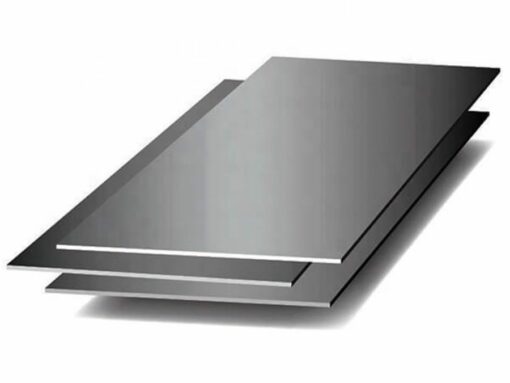What is 2205 Duplex Stainless Steel Sheet and What Are Its Benefits?
2205 Duplex Stainless Steel sheet is a type of stainless steel that belongs to the duplex family of steels. It is characterized by its high strength and excellent corrosion resistance properties. The “2205” in its name refers to the composition of the steel, which typically consists of approximately 22% chromium, 5% nickel, 3% molybdenum, and a balanced amount of iron.
Here are some of the key benefits of 2205 Duplex Stainless Steel:
- Superior Corrosion Resistance: 2205 Duplex Stainless Steel offers excellent resistance to a wide range of corrosive environments, including those containing chlorides and acids. This makes it suitable for use in various industries, such as chemical processing, marine applications, and oil and gas production.
- High Strength: Compared to austenitic stainless steels, 2205 Duplex Stainless Steel has significantly higher strength, allowing for the design of lighter and more compact structures. It has a higher yield strength and ultimate tensile strength, making it suitable for demanding applications where structural integrity is crucial.
- Good Weldability: Despite its higher strength, 2205 Duplex Stainless Steel exhibits good weldability. This allows for easy fabrication and joining of components, providing flexibility in manufacturing processes.
- Excellent Fatigue Resistance: The duplex structure of 2205 stainless steel contributes to its exceptional fatigue resistance, which is particularly important in applications subject to cyclic loading and vibration. This property makes it suitable for applications such as structural components and offshore equipment.
- Cost-Effective: In many cases, 2205 Duplex Stainless Steel can be a cost-effective alternative to other high-performance stainless steels or nickel-based alloys. Its lower nickel content makes it less expensive than austenitic stainless steels, while still offering comparable corrosion resistance and superior strength.
- Good Heat Resistance: 2205 Duplex Stainless Steel retains its mechanical properties and corrosion resistance at elevated temperatures, making it suitable for applications that involve exposure to high temperatures and thermal cycling.
These benefits make 2205 Duplex Stainless Steel a popular choice in various industries, including chemical processing, oil and gas, desalination, pulp and paper, and marine environments. Its combination of strength, corrosion resistance, and cost-effectiveness makes it a versatile material for a wide range of applications.
Understanding the Chemical Composition of 2205 Duplex Stainless Steel Sheets
The chemical composition of 2205 Duplex Stainless Steel sheet typically includes the following elements:
- Chromium (Cr): It is the primary alloying element in stainless steel and provides excellent corrosion resistance. The chromium content in 2205 Duplex Stainless Steel is typically around 21-23%.
- Nickel (Ni): Nickel enhances the toughness and ductility of the steel. It also contributes to its corrosion resistance. The nickel content in 2205 Duplex Stainless Steel is usually about 4.5-6.5%.
- Molybdenum (Mo): Molybdenum improves the pitting and crevice corrosion resistance of the steel, particularly in chloride environments. The molybdenum content in 2205 Duplex Stainless Steel is typically around 2.5-3.5%.
- Nitrogen (N): Nitrogen is added to improve the strength and corrosion resistance of the steel. It also helps in maintaining the austenitic-ferritic structure of the duplex stainless steel. The nitrogen content in 2205 Duplex Stainless Steel is typically about 0.08-0.2%.
- Iron (Fe): Iron is the base metal in stainless steel and provides its structural integrity. The iron content in 2205 Duplex Stainless Steel is the balance of the composition, typically around 65-75%.
In addition to these primary elements, 2205 Duplex Stainless Steel may contain small amounts of other elements such as carbon (C), silicon (Si), manganese (Mn), phosphorus (P), sulfur (S), and copper (Cu). However, these elements are usually present in low concentrations and their exact amounts may vary depending on the specific grade and manufacturer.
It’s worth noting that the chemical composition of 2205 Duplex Stainless Steel is designed to achieve a balanced microstructure of austenite and ferrite, which gives the material its duplex characteristics and desirable properties such as high strength and corrosion resistance.
Types of 2205 Duplex Stainless Steel Sheets & Their Applications
There are several types of 2205 Duplex Stainless Steel sheets available, and their selection depends on specific application requirements. Here are some common types and their applications:
- Standard 2205 Duplex Stainless Steel Sheets: These sheets have a balanced composition of chromium, nickel, molybdenum, and nitrogen. They offer excellent corrosion resistance, high strength, and good weldability. They are widely used in industries such as chemical processing, oil and gas, pulp and paper, and marine environments. Applications include pressure vessels, heat exchangers, tanks, pipes, and structural components.
- Super Duplex 2205 Stainless Steel Sheets: These sheets have an enhanced composition with higher levels of chromium, nickel, and molybdenum, along with added elements such as tungsten and copper. They provide superior corrosion resistance, particularly in aggressive environments with high chloride concentrations. Super duplex 2205 sheets are used in demanding applications such as offshore oil and gas platforms, desalination plants, chemical processing equipment, and seawater systems.
- Lean Duplex 2205 Stainless Steel Sheets: Lean duplex grades have a reduced nickel content compared to standard duplex stainless steels, resulting in cost savings. They offer good corrosion resistance and higher strength than austenitic stainless steels. Lean duplex 2205 sheets are used in various applications such as structural components, storage tanks, architectural applications, and transportation equipment.
- Duplex 2304 Stainless Steel Sheets: Duplex 2304 is a lower-alloyed duplex stainless steel with a balanced composition of chromium, nickel, molybdenum, and nitrogen. It provides good strength and corrosion resistance in moderately corrosive environments. Duplex 2304 sheets find applications in the chemical industry, pulp and paper processing, transportation, and architectural applications.
- Duplex 2507 Stainless Steel Sheets: Duplex 2507 is a highly alloyed duplex stainless steel with increased levels of chromium, nickel, molybdenum, and nitrogen. It offers exceptional corrosion resistance, high strength, and excellent resistance to stress corrosion cracking. Duplex 2507 sheets are commonly used in aggressive environments such as chemical processing plants, offshore and marine applications, and oil and gas production.
These are just a few examples of the types of 2205 Duplex Stainless Steel sheet available. The selection of the appropriate type depends on the specific application’s requirements, including corrosion resistance, strength, and cost considerations. Consulting with a materials engineer or stainless steel supplier can help in choosing the most suitable type for a particular application.
What to Consider When Choosing the Best Grade of 2205 Duplex Stainless Steel Sheet
When choosing the best grade of 2205 Duplex Stainless Steel sheet for a particular application, several factors should be considered. Here are some important considerations:
- Corrosion Resistance: Evaluate the specific corrosive environment the sheet will be exposed to, such as chemicals, seawater, or high chloride concentrations. Select a grade that offers the necessary corrosion resistance for that particular environment. Super duplex grades like 2507 provide enhanced corrosion resistance in aggressive environments.
- Strength and Mechanical Properties: Consider the required strength and mechanical properties for the application. Different grades of 2205 Duplex Stainless Steel offer varying levels of strength. Standard 2205 grades provide good strength, while super duplex grades offer higher strength. Lean duplex grades may be suitable for applications where cost savings and moderate strength are key.
- Weldability: Assess the welding requirements for the application. Duplex stainless steels, including 2205, generally have good weldability. However, some grades may require preheating or post-weld heat treatment. Consider the welding process and ensure the selected grade can be easily welded without compromising its properties.
- Fabrication and Formability: Determine the fabrication processes involved, such as cutting, bending, or machining. Different grades of 2205 Duplex Stainless Steel exhibit varying degrees of formability and ease of fabrication. Consider the required formability for the specific application.
- Temperature and Thermal Stability: Take into account the operating temperature range and any thermal cycling that the sheet may experience. Certain grades of 2205 Duplex Stainless Steel offer better high-temperature strength and thermal stability than others. Assess the temperature limits and select a grade accordingly.
- Cost Considerations: Consider the budget and cost constraints for the project. The various grades of 2205 Duplex Stainless Steel come at different price points. Standard grades are typically more cost-effective, while super duplex or higher-alloyed grades can be more expensive. Balance the desired properties with the project’s budget.
- Application-Specific Requirements: Consider any specific requirements of the application, such as compatibility with other materials, weight considerations, regulatory standards, or industry-specific guidelines. These factors can influence the choice of the appropriate grade.
It is advisable to consult with materials engineers, stainless steel suppliers, or industry experts to select the best grade of 2205 Duplex Stainless Steel sheet based on the specific requirements of the application.
Also Read – The Key Benefits Of Construction Equipment Rental

